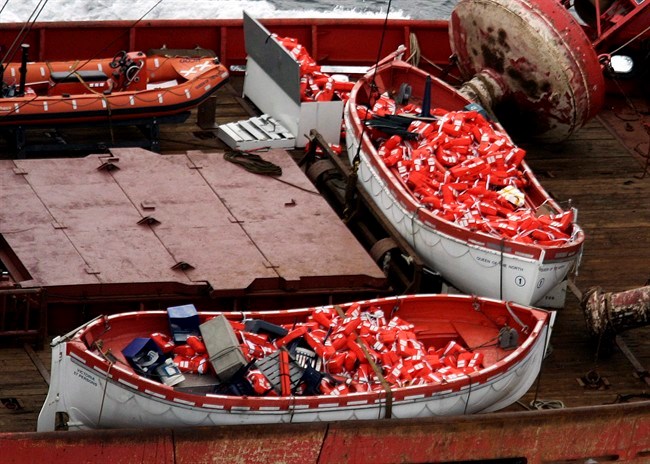VANCOUVER - Marven Robinson still marvels at instincts that jolted him from his bed the night of March 22, 2006, prompting him to tune into his marine radio in time to hear a mayday distress signal that sent him scrambling in darkness to help rescue all but two passengers of a sinking British Columbia ferry.
Memories remain sharp for the First Nations man, from his initial confusion pinpointing the vessel's location to arriving at the sinking ship aboard a gillnetter 40 minutes later.
But in the fatal Queen of the North disaster, he thinks he's an exception.
"It's six years (ago) and people are kind of like, 'Oh my God, it's coming back now.' So everybody is starting to get that worry (that they) don't remember much of that night," he said in an interview.
"But I tell you for me, it's really easy. I can remember what I saw."
One of the ferry's former crew members goes on trial this week, and Robinson expects to join a group of Hartley Bay native band members in relaying his recollection of the incident as a sworn witness.
Almost seven years on, Karl Lilgert will face charges of criminal negligence causing death after the ship crashed into an island and went down along sa国际传媒's northwest coast.
Lilgert was the navigation officer and on the bridge that night, according to a subsequent Transportation Safety Board investigation. He was the officer in charge after the Second Officer went for a scheduled lunch break.
Lilgert has pleaded not guilty to the two counts connected with the deaths of passengers Gerald Foisy and Shirley Rosette, whose bodies were never found. The couple from 100 Mile House was presumed drowned.
On Wednesday, jury selection was conducted.
Neither Lilgert's lawyer or the Crown have commented on why it's taken this long to get to court.
A basic timeline provided by sa国际传媒's criminal justice branch states the initial investigative report was provided to Crown by police in February 2008.
Charges were sworn on March 16, 2010, four years after the incident. A preliminary inquiry was held in provincial court in May 2011, while the indictment was signed the following September.
"Any delay like that is really troubling," Bentley Doyle, spokesman for the Trial Lawyers Association of sa国际传媒, said in an interview.
"It's very tough for everyone involved, for either side of the file."
He said some of the typical causes for delays include difficulty aligning lawyers' schedules, complex disclosure in which lawyers need to read tens of thousands of pages of documents, and a lack of judges.
A trial should commence within 18 months, as justice is jeopardized when the delay creeps towards two years and beyond, Bentley said. Cases have sometimes been thrown out.
Lilgert's lawyer, Glen Orris, told The Canadian Press at the time the charges were approved that his client would plead not guilty.
"He doesn't deny that he is responsible for what happened. He was the person in charge of the ferry at the time that it ran aground, so clearly, he's the one who's responsible," said Orris in March 2010.
"But my view is the mistake or mistakes he may have made don't amount to criminal negligence."
The wreck occurred in the wee morning hours when the ship slammed into Gil Island. It was four hours into its regular run to Port Hardy, on the northern tip of Vancouver Island, from Prince Rupert on the northwest coast.
It took just a little over an hour for the vessel to go down, after striking land at a cruising speed of roughly 30 kilometres an hour.
Passengers were saved by descending into lifeboats and about seven First Nations vessels that came to their aid, arriving before the coast guard.
The ferry's hull plating along the starboard side was ripped open at the waterline.
The trial takes place after a full investigation by the Transportation Safety Board, which concluded with a report in March 2008. In conjunction, the board also made recommendations to bump up safety for ship passengers across sa国际传媒.
The board concluded Canadian passenger vessels should improve procedures for keeping track of passengers and for crew training in an emergency. It also recommended all large Canadian vessels be fitted with voyage data recorders.
sa国际传媒 Ferries also conducted an internal investigation.
Families of the dead passengers in the meantime settled lawsuits with BC Ferries, while a class-action suit was also settled for 45 passengers who made it off the ship.
Robinson, who is a councillor with the native band that's part of the Gitga'at First Nation, said he believes upwards of 15 of his neighbours from the 160-person village could be called as witnesses.
The band has long complained the Queen of the North, still submerged in more than 450 metres of water, poses an environmental threat due to the slow leak of fuel and on-board dish detergent. The 44-year-old said he had to stop digging clams from anywhere near where the ship went down, less than 10 kilometres from his home.
At a time when the proposed Enbridge pipeline project is making perpetual headlines, he's hoping the return of public attention to the incident serves as a reminder of the perils sa国际传媒 wilderness faces from any potential increased ship traffic.
"We're in a time right now where there's a lot of commercial activity planned for the coast here," he said. "We need the public to understand why First Nations feel the way they do about shipping that happens in their territories."



